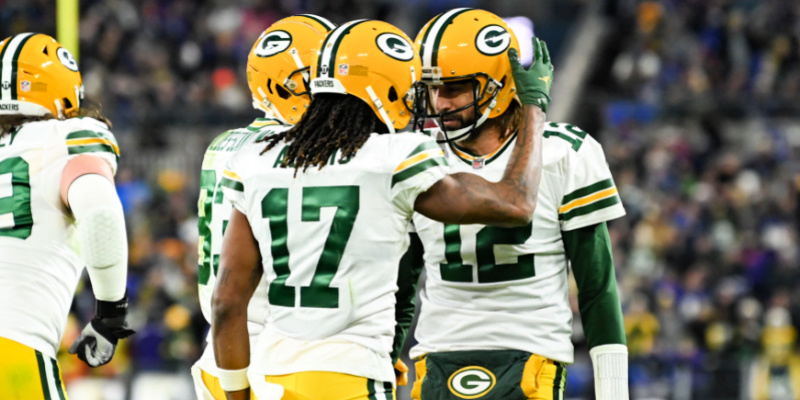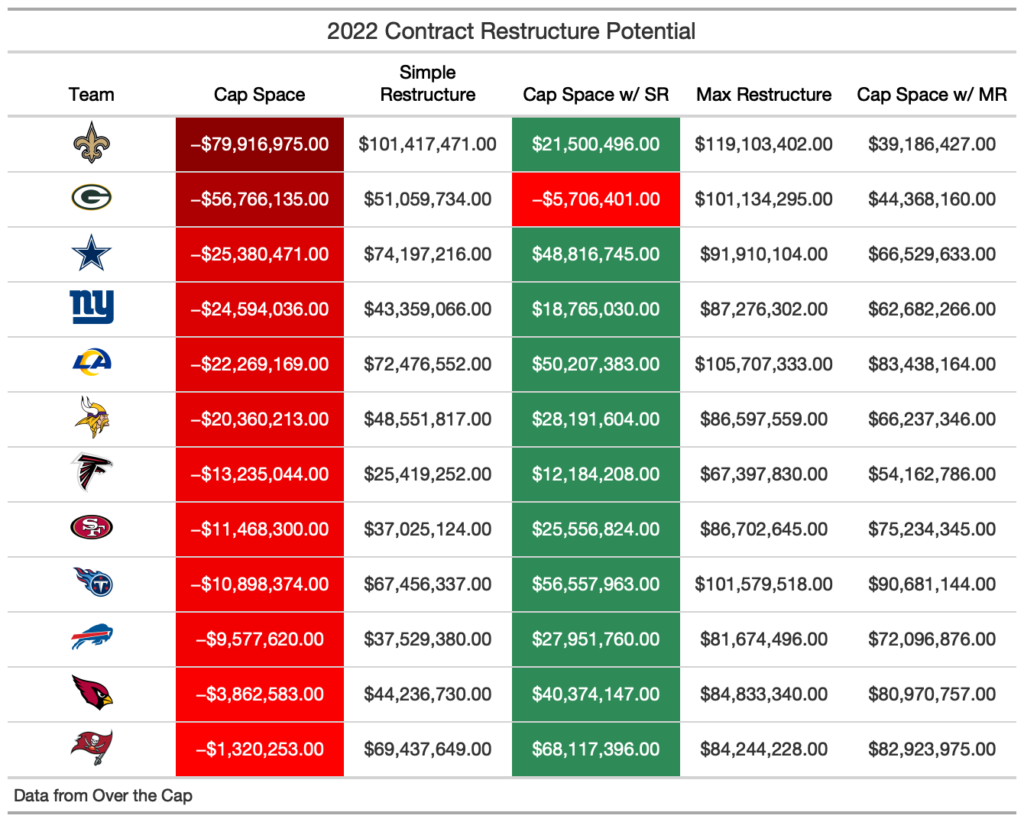Breakdowns
2/23/22
5 min read
How To Get Under The Cap

As the offseason begins and the first day of the 2022 league year on March 16th approaches, much attention will be given to the teams that are projected to be over the $208.2M salary cap. Currently, there are twelve such teams with the Saints and Packers in the most precarious situations. In terms of effective cap space--the maximum amount of space teams will have once they sign 51 players--New Orleans sits at nearly $80M over the cap, and Green Bay is $56.8M in the red. Yet, these teams have various tactics at their disposal that will allow them to adjust contracts to get under the cap. Let’s take a closer look at these options...

Pay Cut/“Adjustment”
If a team is considering cutting a player, they have the option of asking the player to take a pay cut instead of being cut outright. Some teams may even spin it as a “pay adjustment” to make it more digestible on the player’s side. The player then has the option to refuse in which case the team can make the final decision on the release.
Restructures
The most common type of restructure involves converting P5 Base Salary into a signing bonus, allowing the team to prorate that money for the length of the contract (up to five years). Because of current contract language, teams usually can unilaterally execute these restructures; that is, they do not need permission from the player. The truth is, however, that the player benefits from these restructures because they get their money sooner in the form of a signing bonus. The downside from the club perspective is that it will create more cap charges in the future. This is also known as using the “Salary Cap” credit card.
Based on the above chart, the Saints can generate by far the most cap space through these “simple restructures” ($101.4M). The Packers, on the other hand, are the only team that can’t get under the cap through simple restructures alone. They will have to either utilize a max restructure (which will entail adding void years to existing contracts), or they will have to cut some players.
Void Years
Void years are contract years that do not truly exist but are added to the contract for salary cap proration purposes. Teams can prorate money up to a maximum of five years, so for contracts that are for fewer years, teams may look to add void years to increase and extend the prorated money. For example, let’s say a player has two years left on his deal...the team can add three void years to prorate bonuses for the maximum of five years. But the player’s contract will still expire after the two non-void seasons.
For more information on void years, Stephen Dranoff recently expounded upon them in great detail. So, be sure to check out his story.
Extensions
Though it may seem counter-intuitive, teams can extend players to help get under the salary cap in the current season. It is not mutually exclusive by any means to decrease the cap hit in the current season and increase the overall value of the deal through an extension. Two recent examples of this are Jalen Ramsey and Ryan Ramczyk.
In the chart above, Max Restructures include teams’ ability either to extend players or add void years for salary cap purposes. This contrasts with simple restructures which occur within the confines of the current contract; simple restructures therefore do not involve additional years or void years. Although teams can create more cap space through max restructures, they also will need a player’s consent to perform them.
Release Player
Of course, teams have the option of cutting players to create cap space. If they do so, any guaranteed money or prorated money will be accelerated onto the current year’s salary cap. The only exception to this rule involves June 1st, which is a very important date on the NFL calendar...
June 1st Rule
If a player is cut or traded prior to June 1st, all of his prorated money accelerates onto the current season’s cap as dead money. Yet, if he’s traded or cut after June 1st, only his prorated money in the current season gets charged to the current season’s cap; the rest of the balance accelerates next season. As an example, Russell Wilson has $13M prorated bonuses in 2022 and 2023. If he’s traded prior to June 1st, the Seahawks dead money charge in 2022 will be all $26M. If he’s traded after June 1st, they will have $13M in dead money in 2022 and $13M in 2023.
The crucial stipulation here is that the league allows teams to designate two players as June 1st cuts for cap purposes. In turn, this allows the players to be cut in March yet be treated as a player who was cut after June 1st in terms of dead money.
Trades
In many other sports, when a player is traded, the team acquiring the player inherits his entire contract such that his previous team doesn’t carry any of the financial burden once the player is dealt. This is not the case in the NFL. Any prorated money will accelerate onto the previous team’s cap, as that money was already paid to the player as a bonus. To illustrate this, let’s look at Deshaun Watson as an example. The Texans will eat $16.2M of Watson’s prorated bonus as dead money if they trade him. This will decrease his cap charges from 2022-2024 by $5.4M in each season, making his contract team-friendly for whoever acquires him.







